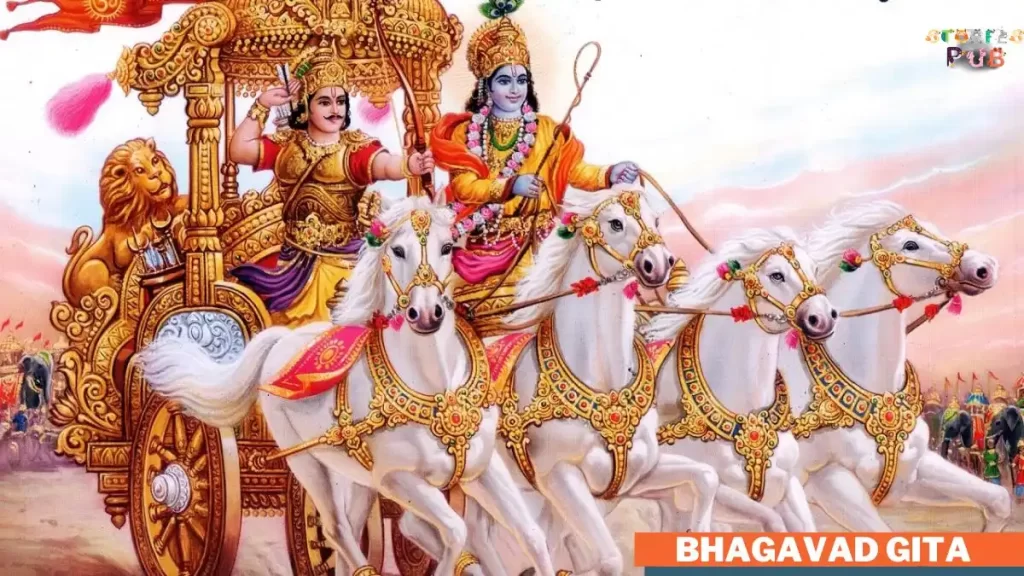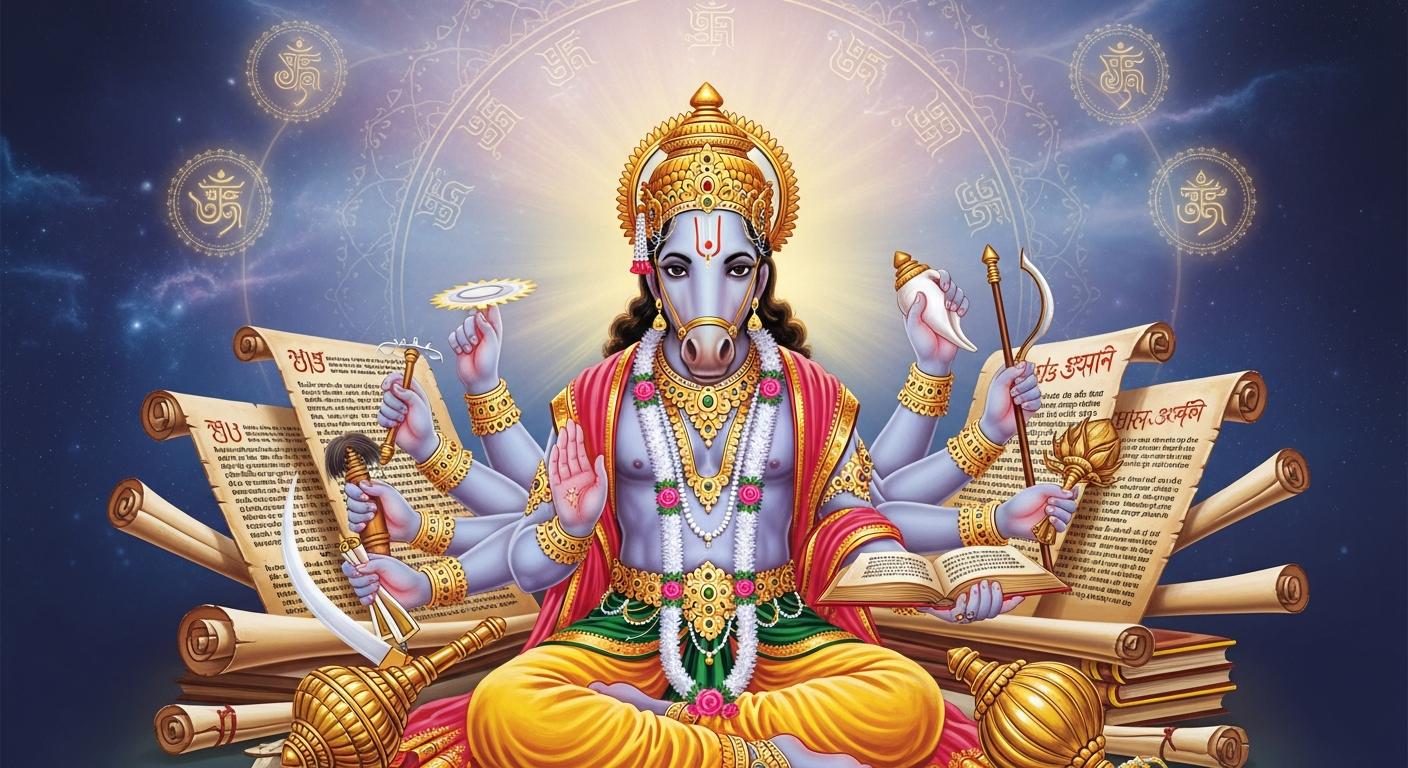Summarize this Article with:
The Bhagavad Gita: Dialogues and Guide to Living a Meaningful Life

The Bhagavad Gita is a Hindu scripture that has been highly revered and studied for thousands of years. It is a part of the ancient Indian epic, the Mahabharata, and is believed to have been composed between the fifth and second centuries BCE. The text consists of a dialogue between Lord Krishna and Arjuna, two central characters in the Mahabharata, who engage in a profound philosophical conversation on the battlefield of Kurukshetra.
The Bhagavad Gita is composed of 18 chapters, each of which contains between 40 and 78 verses. The text is written in Sanskrit and has been translated into many languages over the centuries. It has been a source of inspiration and guidance for millions of people around the world, and is considered one of the most important texts in the Hindu canon.
The Bhagavad Gita contains a wealth of teachings on a wide range of topics, including dharma (duty), karma (action), yoga (meditation), and the nature of the self. It offers a unique perspective on the relationship between the individual and the divine, and provides practical guidance on how to live a fulfilling and meaningful life.
The Bhagavad Gita is divided into three main sections. The first section, known as the Karma Yoga, discusses the nature of action and the importance of performing one’s duties without attachment to the fruits of one’s actions. The second section, known as the Bhakti Yoga, focuses on the path of devotion and the importance of developing a loving relationship with the divine. The final section, known as the Jnana Yoga, explores the nature of knowledge and the importance of self-realization.
Throughout the text, Lord Krishna emphasizes the importance of living a life of dharma, or duty. He encourages Arjuna to perform his duties as a warrior without attachment to the outcome, and teaches him the importance of surrendering to the divine will. He also stresses the importance of meditation and self-reflection as a means of achieving self-realization.
Historical background of the text
The historical background of the Bhagavad Gita is complex and multifaceted, with scholars offering different interpretations of its origins and development over time. However, it is generally believed that the text was composed in the context of the Mahabharata, an ancient Indian epic that tells the story of a great war between two royal families.
The Mahabharata is believed to have been composed over a long period of time, possibly stretching back to the second millennium BCE. It was likely transmitted orally for many centuries before being written down in its current form in the fourth century CE. The text contains a wide variety of stories, teachings, and philosophical discussions, and has had a profound impact on Indian culture and religion.
The Bhagavad Gita is a small part of the Mahabharata, but it has become one of its most important and influential sections. Its composition is believed to have taken place sometime between the fifth and second centuries BCE, during a period of great intellectual and spiritual ferment in India. It was likely written by multiple authors over a long period of time, with the final version being compiled and edited at a later date.
The Bhagavad Gita has been the subject of intense study and commentary over the centuries, with scholars and spiritual leaders offering a wide range of interpretations and insights into its teachings. It has been translated into many languages and has had a profound impact on spiritual traditions around the world.
Overall, the historical background of the Bhagavad Gita is complex and multifaceted, reflecting the rich cultural and intellectual history of India. Its teachings continue to inspire and guide people of all backgrounds and beliefs to this day.
Introduction to Lord Krishna and Arjuna
Lord Krishna and Arjuna are two central characters in the Bhagavad Gita, and their relationship forms the foundation of the text. Here’s a detailed overview of each character:
Lord Krishna: Lord Krishna is one of the most important deities in Hinduism, and is revered as the eighth avatar of Lord Vishnu. He is believed to have lived around 5,000 years ago and is considered a great teacher, philosopher, and leader. In the Bhagavad Gita, he serves as a spiritual guide to Arjuna, offering him insights and teachings on a wide range of topics.
Lord Krishna is depicted as a wise and compassionate figure, with a deep understanding of the nature of existence and the human condition. He is often described as an embodiment of love, and his teachings emphasize the importance of cultivating a loving relationship with the divine.
Arjuna: Arjuna is a central character in the Mahabharata, and is one of the greatest warriors of his time. In the Bhagavad Gita, he is faced with a moral dilemma when he realizes that he must fight against his own relatives in a great war. Arjuna becomes overwhelmed with doubt and confusion, and turns to Lord Krishna for guidance.
Arjuna’s character is complex and multifaceted, reflecting the challenges and dilemmas faced by human beings in their quest for spiritual understanding. He represents the struggle between duty and desire, and his journey towards self-realization is a central theme of the Bhagavad Gita.
The relationship between Lord Krishna and Arjuna is a key aspect of the Bhagavad Gita. Lord Krishna serves as a mentor and guide to Arjuna, helping him to navigate the complexities of life and offering him insights and teachings on a wide range of topics. The dynamic between the two characters reflects the importance of mentorship and guidance in the spiritual journey, and continues to inspire and guide people of all backgrounds and beliefs.
Their roles in the story
Lord Krishna: Lord Krishna serves as the spiritual guide and mentor to Arjuna, helping him to understand the nature of existence and the human condition. Throughout the text, he offers Arjuna teachings on a wide range of topics, including dharma, karma, and the nature of the self.
Lord Krishna is portrayed as a wise and compassionate figure, with a deep understanding of the challenges and dilemmas faced by human beings. He provides Arjuna with practical guidance on how to live a fulfilling and meaningful life, and stresses the importance of developing a loving relationship with the divine.
In addition to his role as a spiritual guide, Lord Krishna is also depicted as a warrior and leader. He plays a key role in the Kurukshetra war, offering support and guidance to the Pandavas, the family that Arjuna is fighting for.
Arjuna: Arjuna is a central figure in the Bhagavad Gita, and serves as a representation of humanity’s struggle to understand the nature of existence. He is faced with a moral dilemma when he realizes that he must fight against his own relatives in a great war.
Throughout the text, Arjuna represents the struggle between duty and desire. He becomes overwhelmed with doubt and confusion, and turns to Lord Krishna for guidance. With Lord Krishna’s help, Arjuna is able to gain a deeper understanding of his duty as a warrior and the nature of the self.
Arjuna’s journey towards self-realization is a key theme of the Bhagavad Gita. He learns to let go of his attachment to the outcome of his actions, and instead focuses on performing his duty with a sense of detachment. Through this process, he is able to transcend the limitations of the ego and come closer to the divine.
The significance of their relationship
Mentorship:
The relationship between Lord Krishna and Arjuna represents the importance of mentorship and guidance in the spiritual journey. Lord Krishna serves as a mentor and guide to Arjuna, helping him to navigate the complexities of life and offering him insights and teachings on a wide range of topics.
Trust:
The relationship between Lord Krishna and Arjuna is built on a foundation of trust. Arjuna trusts Lord Krishna’s guidance and wisdom, and is willing to follow his teachings, even when they challenge his beliefs and assumptions.
Love:
The relationship between Lord Krishna and Arjuna is also characterized by love. Lord Krishna is described as an embodiment of love, and his teachings emphasize the importance of cultivating a loving relationship with the divine. Through their interactions, Lord Krishna and Arjuna demonstrate the power of love to transform the human heart and bring us closer to the divine.
Unity:
The relationship between Lord Krishna and Arjuna also reflects the importance of unity in the spiritual journey. Lord Krishna and Arjuna come from different backgrounds and have different roles in the Kurukshetra war, but they are able to work together towards a common goal. This unity represents the power of spiritual teachings to transcend cultural, social, and ideological barriers.
Self-realization:
Ultimately, the relationship between Lord Krishna and Arjuna is significant because it represents the journey towards self-realization. Through their interactions, Arjuna is able to gain a deeper understanding of the nature of existence and the human condition. He learns to let go of his attachment to the outcome of his actions, and instead focuses on performing his duty with a sense of detachment. Through this process, he is able to come closer to the divine and achieve a state of self-realization.
Historical background of the Kurukshetra war
The Mahabharata:
The Kurukshetra war is a part of the Mahabharata, an ancient Indian epic that tells the story of a great war between two royal families, the Kuru and the Pandava clans. The Mahabharata is believed to have been composed over a long period of time, possibly stretching back to the second millennium BCE, and is considered one of the greatest literary works in Indian history.
The Kuru dynasty:
The Kuru dynasty was one of the most powerful and influential royal families in ancient India, with a lineage that was believed to stretch back to the mythical King Bharata. The Kuru capital was located in the region of Hastinapura, in what is now the state of Uttar Pradesh.
The Pandava brothers:
The Pandavas were the five sons of King Pandu, who was the younger brother of the Kuru king Dhritarashtra. The Pandavas were raised alongside their cousins, the Kauravas, and were trained in the arts of warfare and governance.
The dispute:
The Kurukshetra war was sparked by a dispute between the Pandavas and the Kauravas over the rightful succession to the Kuru throne. The Kauravas, led by the eldest brother Duryodhana, refused to acknowledge the Pandavas’ claim to the throne, and instead sought to marginalize and humiliate them.
The war:
The Kurukshetra war lasted for 18 days, and was one of the bloodiest and most brutal conflicts in ancient Indian history. The Pandavas were ultimately victorious, but the war left a deep scar on Indian society and culture.
Historical context:
The Kurukshetra war took place during a period of great political, social, and cultural change in ancient India. It marked the end of the Vedic period and the beginning of the epic period, and had a profound impact on the development of Indian culture and religion.
The significance of the battlefield
Symbolism:
The battlefield of Kurukshetra is not just a physical location, but also holds symbolic significance. It represents the battlefield of life, where we are all engaged in a struggle to overcome our inner demons and achieve self-realization. The battlefield is a metaphor for the human condition, and the struggles that we all face in our journey towards spiritual understanding.
Dharma:
The battlefield of Kurukshetra is also significant because it represents the importance of dharma, or duty. The Pandavas, led by Arjuna, are fighting on the side of dharma, while the Kauravas are fighting for their own selfish interests. The battle is a metaphor for the struggle between good and evil, and the importance of upholding one’s duty even in the face of great challenges.
Karma:
The battlefield of Kurukshetra also represents the importance of karma, or the consequences of our actions. The characters in the Bhagavad Gita are all bound by the law of karma, which dictates that every action has a consequence. The battle on the battlefield is a manifestation of the characters’ past actions, and serves as a reminder of the importance of acting with intention and mindfulness.
Self-realization:
The battlefield of Kurukshetra is also significant because it serves as a catalyst for Arjuna’s journey towards self-realization. It is on the battlefield that Arjuna is forced to confront his inner doubts and fears, and seek guidance from Lord Krishna. Through his interactions with Lord Krishna, Arjuna is able to gain a deeper understanding of the nature of existence and the human condition, and ultimately achieve a state of self-realization.
Significance of the battlefield of Kurukshetra lies in its symbolic and metaphorical importance. It represents the struggles and challenges of the human condition, and the importance of upholding one’s duty, acting with intention and mindfulness, and seeking guidance on the path towards self-realization.
Overview of the conversation between Lord Krishna and Arjuna
The conversation begins with Arjuna expressing his doubts and fears about the upcoming battle. He is torn between his sense of duty as a warrior and his concern for the moral implications of fighting against his own family members. He tells Lord Krishna:
Arjuna: “O Krishna, I am overcome with grief and confusion. How can I fight against my own family members, my own teachers and friends? What good will come of this war, when it will only lead to the destruction of our own people?”
Lord Krishna responds to Arjuna with words of wisdom and guidance.
Lord Krishna: “Arjuna, you are grieving for those who should not be grieved for, and you speak words of wisdom that are not worthy of you. The body is mortal, but the soul is eternal. The soul cannot be destroyed by weapons or fire or water. It is unchanging and eternal.”
Lord Krishna goes on to explain the nature of the self and the importance of performing one’s duty without attachment to the outcome. He tells Arjuna:
Lord Krishna: “You have a duty to fulfill as a warrior, Arjuna. You must fight for what is right, without concern for the fruits of your actions. Perform your duty with detachment, and do not be attached to the outcome. It is the attachment to the outcome that leads to grief and suffering.”
As the conversation between Lord Krishna and Arjuna continues, Lord Krishna offers Arjuna insights and teachings on a wide range of topics, including the nature of existence, the importance of detachment, and the path towards spiritual enlightenment. Throughout their interactions, Lord Krishna serves as a mentor and guide to Arjuna, helping him to navigate the complexities of life and offering him practical guidance on how to live a fulfilling and meaningful life.
Their conversation reaches its climax with Lord Krishna revealing his true nature as the Supreme Being. He tells Arjuna:
Lord Krishna: “Arjuna, I am the Supreme Being, the source of all that exists. All things come from me, and all things return to me. I am the beginning and the end, the first and the last.”
Arjuna is awed and humbled by Lord Krishna’s revelation, and begins to understand the true nature of existence. The conversation between Lord Krishna and Arjuna ends with Arjuna expressing his gratitude and reverence for Lord Krishna’s teachings. He says:
Arjuna: “My dear Lord, I have heard your teachings with a focused mind, and my doubts have been dispelled. Your words are like nectar to me, and I am eternally grateful for your guidance. I am now ready to do your bidding and fulfill my duty as a warrior.”
The conversation between Lord Krishna and Arjuna is a powerful and transformative dialogue that continues to inspire and guide people of all backgrounds and beliefs. Its teachings on the nature of existence, the importance of detachment, and the path towards spiritual enlightenment continue to resonate with readers around the world.
Key themes and teachings in the dialogue
The conversation between Lord Krishna and Arjuna in the Bhagavad Gita is rich with themes and teachings that are still relevant and meaningful today. Here’s a detailed overview of some of the key themes and teachings in the dialogue:
Dharma:
Dharma, or one’s duty, is a central theme in the Bhagavad Gita. Lord Krishna emphasizes the importance of performing one’s duty without attachment to the outcome, and teaches Arjuna that his duty as a warrior is to fight for what is right, even if it means fighting against his own family members.
Karma:
Karma, or the consequences of one’s actions, is another important theme in the Bhagavad Gita. Lord Krishna teaches Arjuna that every action has a consequence, and that we must be mindful of our actions and their impact on ourselves and others.
Self-realization:
The ultimate goal of the Bhagavad Gita is self-realization, or the realization of one’s true nature as a spiritual being. Lord Krishna teaches Arjuna that the true nature of the self is eternal and unchanging, and that we must look beyond the temporary nature of the physical world to achieve self-realization.
Detachment:
Detachment from the outcome of our actions is another important theme in the Bhagavad Gita. Lord Krishna teaches Arjuna that attachment to the outcome leads to suffering, and that we must perform our duties with detachment and without expectation.
Love:
Love, particularly divine love, is a key teaching in the Bhagavad Gita. Lord Krishna is described as an embodiment of love, and teaches Arjuna that love is the most powerful force in the universe. Through their interactions, Lord Krishna and Arjuna demonstrate the power of love to transform the human heart and bring us closer to the divine.
Unity:
The importance of unity is also emphasized in the Bhagavad Gita. Lord Krishna and Arjuna come from different backgrounds and have different roles in the Kurukshetra war, but they are able to work together towards a common goal. This unity represents the power of spiritual teachings to transcend cultural, social, and ideological barriers.
Structure of the dialogue and its significance
The structure of the dialogue between Lord Krishna and Arjuna in the Bhagavad Gita is a key aspect of its significance. Here’s a detailed overview of the structure and its significance:
The Setting:
The dialogue takes place on the battlefield of Kurukshetra, providing a specific context for the conversation between Lord Krishna and Arjuna. The setting serves as a metaphor for the human condition, and the struggles that we all face in our journey towards spiritual understanding.
The Introduction:
Arjuna talks about his doubts and fears about the battle that is coming up. This sets the stage for Lord Krishna to give him advice and lessons.
The Teachings:
Lord Krishna offers a series of teachings and insights to Arjuna, touching on a wide range of topics including the nature of existence, the importance of detachment, and the path towards spiritual enlightenment. The teachings are presented in a clear and practical way, making them accessible and applicable to readers of all backgrounds and beliefs.
The Revelation:
Lord Krishna reveals his true nature as the Supreme Being, offering a profound and transformative insight into the nature of existence and the ultimate goal of self-realization.
The Conclusion:
Arjuna expresses his gratitude and reverence for Lord Krishna’s teachings, and demonstrates his understanding and acceptance of the wisdom he has received.
The importance of the Bhagavad Gita in contemporary society
The text continues to inspire and guide millions of people around the world, regardless of their religious or cultural backgrounds. Here are some reasons why the Bhagavad Gita remains important in contemporary society:
Spiritual guidance:
The Bhagavad Gita is considered one of the most important texts in Hinduism, and is revered for its teachings on spirituality, morality, and personal growth. Its insights on karma, dharma, and self-realization offer guidance to people seeking to live a more meaningful and fulfilling life.
Universal relevance:
The Bhagavad Gita’s teachings are not limited to Hinduism, but have universal appeal. Its emphasis on living a life of duty, cultivating devotion, and pursuing self-realization can be applied to people of all cultures and backgrounds.
Inspiration for leaders:
The Bhagavad Gita has inspired many leaders and thinkers throughout history, including Mahatma Gandhi, who saw it as a guide to nonviolent resistance and social change. Its teachings on leadership, duty, and moral courage continue to inspire people in positions of power and influence.
Influence on culture:
The Bhagavad Gita has had a profound influence on Indian culture and has inspired many works of art, literature, and music. Its teachings have been incorporated into many aspects of Indian life, including politics, education, and social norms.
Global impact:
The Bhagavad Gita has been translated into many languages and has had a significant impact on spiritual traditions around the world. Its teachings have influenced the development of yoga, meditation, and other spiritual practices, and continue to inspire people of all backgrounds to seek greater understanding and enlightenment.
Dharma and its role in the Bhagavad Gita
Definition:
Dharma is often translated as “duty” or “righteousness” and refers to the moral and ethical principles that guide our actions. In the context of the Bhagavad Gita, dharma refers to the duty of a warrior to fight for what is right and just.
Importance:
Dharma is an important concept in the Bhagavad Gita because it emphasizes the importance of performing one’s duty without attachment to the outcome. Lord Krishna teaches Arjuna that his duty as a warrior is to fight for what is right, even if it means fighting against his own family members. The importance of dharma lies in its ability to guide our actions in a way that is ethical, moral, and just.
Context:
The context of the Kurukshetra war provides a specific context for the discussion of dharma in the Bhagavad Gita. The war is a metaphor for the struggle between good and evil, and the importance of upholding one’s duty in the face of great challenges. Arjuna’s doubts and fears about fighting against his own family members reflect the moral complexity of the situation, and Lord Krishna’s teachings on dharma provide guidance for navigating this complexity.
Consequences:
Lord Krishna teaches Arjuna that every action has consequences, and that we must be mindful of our actions and their impact on ourselves and others. The consequences of our actions are governed by the law of karma, which dictates that every action has a consequence. The importance of dharma lies in its ability to guide us towards actions that are ethical and moral, and ultimately lead to positive consequences.
Spiritual Growth:
The pursuit of dharma is also a key aspect of spiritual growth in the Bhagavad Gita. Lord Krishna teaches Arjuna that the pursuit of dharma leads to self-realization and liberation from the cycle of birth and death. The pursuit of dharma is thus not only important for ethical and moral reasons, but also for spiritual reasons.
Dharma plays a central role in the Bhagavad Gita, emphasizing the importance of performing one’s duty, being mindful of the consequences of our actions, and pursuing a path of spiritual growth. The pursuit of dharma is not only important for individuals, but also for society as a whole, and provides a framework for ethical and moral decision-making.
Karma and its significance
Karma also plays a central concept in the Bhagavad Gita and plays a significant role in the dialogue between Lord Krishna and Arjuna. Here’s a detailed overview of karma and its significance in the Bhagavad Gita:
Definition:
Karma refers to the consequences of our actions, both in this life and in future lives. In the context of the Bhagavad Gita, karma is governed by the law of cause and effect, which states that every action has a consequence.
Significance:
The concept of karma is significant in the Bhagavad Gita because it emphasizes the importance of being mindful of our actions and their impact on ourselves and others. Lord Krishna teaches Arjuna that every action has consequences, and that we must be mindful of the consequences of our actions. The concept of karma thus provides a framework for ethical and moral decision-making, emphasizing the importance of acting in a way that is both ethical and moral.
Types of Karma:
In the Bhagavad Gita, there are three types of karma: sanchita karma, prarabdha karma, and kriyamana karma. Sanchita karma refers to the accumulated karma from past lives, while prarabdha karma refers to the karma that is currently being experienced in this life. Kriyamana karma refers to the karma that is currently being created through our actions.
The Law of Cause and Effect:
The concept of karma is governed by the law of cause and effect. Every action has a consequence, and those consequences are determined by the nature of the action itself. Positive actions lead to positive consequences, while negative actions lead to negative consequences.
Detachment:
The concept of detachment is also significant in the context of karma. Lord Krishna teaches Arjuna that we must perform our actions without attachment to the outcome, as attachment to the outcome can lead to suffering. The concept of detachment thus provides a framework for ethical and moral decision-making that is grounded in a sense of detachment and equanimity.
The nature of the self in the Bhagavad Gita
Here’s a detailed overview of the nature of the self in the Bhagavad Gita:
The True Self:
The Bhagavad Gita teaches that the true nature of the self is eternal and unchanging. The body and mind are temporary and subject to change, but the self is eternal and unchanging.
The Atman:
The true self is often referred to as the Atman in the Bhagavad Gita. The Atman is the essence of the self, and is the same in all beings. It is the source of consciousness and is unchanging and eternal.
The Illusion of Separation:
Lord Krishna teaches Arjuna that the illusion of separation is the root cause of suffering. We believe ourselves to be separate individuals, but in reality, we are all part of the same eternal self. The illusion of separation leads to attachment, desire, and suffering.
The Path Towards Self-Realization:
The path towards self-realization is a central focus of the Bhagavad Gita. Lord Krishna teaches Arjuna that the pursuit of self-realization is the ultimate goal of human life. Self-realization involves the realization that the true nature of the self is eternal and unchanging, and that we are all part of the same eternal self.
The Importance of Meditation:
Lord Krishna emphasizes the importance of meditation as a means of achieving self-realization. Through meditation, we can connect with the true nature of the self and transcend the illusions of the material world. The practice of meditation allows us to cultivate a deeper awareness of the self and can help us to overcome the illusions of separation and attachment.
Overall, the nature of the self in the Bhagavad Gita is a profound and complex concept that underscores the ultimate goal of human life: the realization of the true nature of the self. The Bhagavad Gita teaches that the true self is eternal and unchanging, and that the pursuit of self-realization is the path towards liberation from the cycle of birth and death.
Other key teachings in the text
In addition to the themes of dharma, karma, the nature of the self, and love, there are many other key teachings in the Bhagavad Gita. Here’s a brief overview of some of the other key teachings in the text:
The Importance of Discipline:
Lord Krishna emphasizes the importance of discipline in the pursuit of spiritual growth. Discipline involves controlling the senses and the mind, and cultivating a sense of detachment from the material world.
The Importance of Faith:
Faith is a key element of spiritual growth in the Bhagavad Gita. Lord Krishna teaches Arjuna that faith is necessary for the pursuit of self-realization, and that a deep and abiding faith in the divine is the foundation of spiritual life.
The Importance of Surrender:
Surrender to the divine is another key teaching in the Bhagavad Gita. Lord Krishna teaches Arjuna that surrender is necessary for spiritual growth, and that surrender involves letting go of the ego and placing one’s faith in the divine.
The Importance of Service:
Service to others is a key aspect of spiritual growth in the Bhagavad Gita. Lord Krishna teaches Arjuna that service to others is a noble pursuit, and that serving others with devotion and selflessness is a path towards spiritual growth.
The Illusion of Material Wealth:
Lord Krishna teaches Arjuna that material wealth is an illusion, and that true wealth lies in the pursuit of spiritual growth. The pursuit of material wealth can lead to attachment, desire, and suffering, and Lord Krishna encourages Arjuna to let go of his attachment to material possessions.
The Power of Mantra:
Lord Krishna teaches Arjuna the power of mantra, or sacred sound, as a means of connecting with the divine. Chanting mantras can help to purify the mind and cultivate a sense of devotion and connection to the divine.
Significance of the Bhagavad Gita in contemporary society
The Bhagavad Gita is a timeless text that has remained relevant and influential throughout history, and continues to hold great significance in contemporary society. Here’s a detailed overview of the significance of the Bhagavad Gita in contemporary society:
Spiritual Guidance:
The Bhagavad Gita offers practical guidance and insights into the nature of existence, the pursuit of self-realization, and the path towards spiritual growth. In an age where many people are searching for meaning and purpose, the teachings of the Bhagavad Gita offer a profound and transformative way of understanding the world and our place in it.
Ethics and Morality:
The teachings of the Bhagavad Gita emphasize the importance of ethics and morality in our actions and decisions. The concepts of dharma and karma provide a framework for ethical decision-making that is grounded in a sense of duty and responsibility, and can help us to navigate the complexities of modern society with clarity and wisdom.
Interfaith Dialogue:
The Bhagavad Gita has played an important role in interfaith dialogue, fostering understanding and respect between different religions and cultures. Its teachings emphasize the importance of universal values such as love, compassion, and selflessness, and can help to bridge the gaps between different faith traditions.
Mental Health:
The teachings of the Bhagavad Gita can also be applied to the realm of mental health, offering insights into mindfulness, stress reduction, and the cultivation of inner peace. The practice of meditation, which is emphasized in the text, has been shown to have a wide range of mental health benefits, including reduced stress and anxiety, improved focus and concentration, and increased feelings of well-being.
Environmental Ethics:
The Bhagavad Gita also offers insights into environmental ethics and sustainability, emphasizing the importance of living in harmony with nature and recognizing the interconnectedness of all living beings. The concept of ahimsa, or non-violence, is particularly relevant in this context, as it encourages us to live in a way that is gentle and compassionate towards all living beings.
How the teachings of the text are relevant today
The teachings of the Bhagavad Gita continue to be relevant and applicable in today’s world, offering practical guidance and insights into a wide range of issues and challenges. Here are some ways in which the teachings of the text are relevant today:
Mindfulness and Stress Reduction:
The practice of mindfulness, which is emphasized in the Bhagavad Gita, has been shown to have a wide range of mental health benefits, including reduced stress and anxiety. In today’s fast-paced and stressful world, the teachings of the Bhagavad Gita can provide valuable insights into mindfulness and stress reduction.
Ethics and Morality:
The concepts of dharma and karma, which are central to the teachings of the Bhagavad Gita, offer a framework for ethical decision-making that is grounded in a sense of duty and responsibility. In a world where ethical and moral issues are increasingly complex and challenging, the teachings of the Bhagavad Gita can provide practical guidance and insights.
Interfaith Dialogue:
The Bhagavad Gita has played an important role in interfaith dialogue, fostering understanding and respect between different religions and cultures. Its teachings emphasize the importance of universal values such as love, compassion, and selflessness, and can help to bridge the gaps between different faith traditions.
Environmental Ethics:
The teachings of the Bhagavad Gita offer insights into environmental ethics and sustainability, emphasizing the importance of living in harmony with nature and recognizing the interconnectedness of all living beings. In a world where environmental issues are becoming increasingly urgent, the teachings of the Bhagavad Gita can provide valuable guidance and insights.
Personal Growth and Development:
The teachings of the Bhagavad Gita offer a path towards personal growth and development, emphasizing the importance of self-realization and the pursuit of spiritual growth. In today’s world, where many people are searching for meaning and purpose, the teachings of the Bhagavad Gita can provide valuable insights into the nature of existence and our place in the world.
Lessons we can learn from the Bhagavad Gita
Mindfulness:
The practice of mindfulness, which is emphasized in the Bhagavad Gita, can help us to cultivate a deeper awareness of ourselves and the world around us. Through mindfulness, we can become more present in the moment, and develop a greater sense of inner peace and well-being.
Ethics and Morality:
The teachings of the Bhagavad Gita emphasize the importance of ethical and moral decision-making. The concepts of dharma and karma provide a framework for ethical decision-making that is grounded in a sense of duty and responsibility, and can help us to navigate the complexities of life with clarity and wisdom.
Interconnectedness:
The Bhagavad Gita teaches us that all beings are interconnected, and that our actions have consequences not just for ourselves, but for the world around us. By recognizing our interconnectedness, we can cultivate a greater sense of empathy and compassion towards others.
Self-Realization:
The pursuit of self-realization, which is a central focus of the Bhagavad Gita, involves the realization that the true nature of the self is eternal and unchanging. By cultivating a deeper awareness of the true nature of the self, we can overcome the illusions of the material world and connect with a deeper sense of meaning and purpose.
Detachment:
The concept of detachment, which is emphasized in the Bhagavad Gita, involves letting go of our attachment to the outcomes of our actions. By cultivating a sense of detachment, we can reduce our attachment to material possessions and cultivate a deeper sense of inner peace.
Service:
The Bhagavad Gita teaches us the importance of service to others, emphasizing that serving others with devotion and selflessness is a path towards spiritual growth. By serving others, we can cultivate a deeper sense of connection and purpose in our lives.
Summary of key points:
The Bhagavad Gita is a profound and transformative text that offers a wide range of lessons and insights into the nature of existence and the path towards spiritual growth. Some of the key themes and teachings of the text include dharma, karma, the nature of the self, love, ethics and morality, mindfulness, interconnectedness, detachment, service, and the pursuit of self-realization.
I encourage readers to explore the Bhagavad Gita further, either by reading the text itself or by engaging with the teachings in other ways, such as through meditation, yoga, or other spiritual practices. By deepening our understanding of the teachings of the Bhagavad Gita, we can cultivate a deeper sense of connection to ourselves, others, and the world around us, and live more meaningful and fulfilling lives.
Hey kids, how much did you like The Bhagavad Gita: Dialogues and Guide to Living a Meaningful Life? Please share your view in the comment box. Also, please share this story with your friends on social media so they can also enjoy it, and for more such Hindu Mythology, , please bookmark storiespub.com.
Check out other stories that we have:











